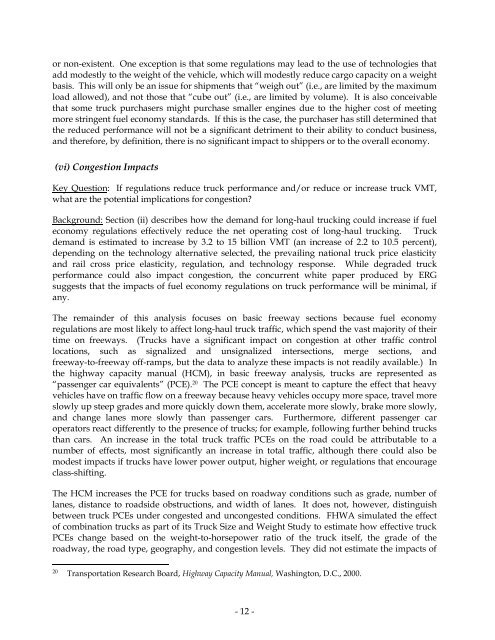Assessment of Fuel Economy Technologies for Medium and Heavy ...
Assessment of Fuel Economy Technologies for Medium and Heavy ...
Assessment of Fuel Economy Technologies for Medium and Heavy ...
You also want an ePaper? Increase the reach of your titles
YUMPU automatically turns print PDFs into web optimized ePapers that Google loves.
or non-existent. One exception is that some regulations may lead to the use <strong>of</strong> technologies that<br />
add modestly to the weight <strong>of</strong> the vehicle, which will modestly reduce cargo capacity on a weight<br />
basis. This will only be an issue <strong>for</strong> shipments that ―weigh out‖ (i.e., are limited by the maximum<br />
load allowed), <strong>and</strong> not those that ―cube out‖ (i.e., are limited by volume). It is also conceivable<br />
that some truck purchasers might purchase smaller engines due to the higher cost <strong>of</strong> meeting<br />
more stringent fuel economy st<strong>and</strong>ards. If this is the case, the purchaser has still determined that<br />
the reduced per<strong>for</strong>mance will not be a significant detriment to their ability to conduct business,<br />
<strong>and</strong> there<strong>for</strong>e, by definition, there is no significant impact to shippers or to the overall economy.<br />
(vi) Congestion Impacts<br />
Key Question: If regulations reduce truck per<strong>for</strong>mance <strong>and</strong>/or reduce or increase truck VMT,<br />
what are the potential implications <strong>for</strong> congestion<br />
Background: Section (ii) describes how the dem<strong>and</strong> <strong>for</strong> long-haul trucking could increase if fuel<br />
economy regulations effectively reduce the net operating cost <strong>of</strong> long-haul trucking. Truck<br />
dem<strong>and</strong> is estimated to increase by 3.2 to 15 billion VMT (an increase <strong>of</strong> 2.2 to 10.5 percent),<br />
depending on the technology alternative selected, the prevailing national truck price elasticity<br />
<strong>and</strong> rail cross price elasticity, regulation, <strong>and</strong> technology response. While degraded truck<br />
per<strong>for</strong>mance could also impact congestion, the concurrent white paper produced by ERG<br />
suggests that the impacts <strong>of</strong> fuel economy regulations on truck per<strong>for</strong>mance will be minimal, if<br />
any.<br />
The remainder <strong>of</strong> this analysis focuses on basic freeway sections because fuel economy<br />
regulations are most likely to affect long-haul truck traffic, which spend the vast majority <strong>of</strong> their<br />
time on freeways. (Trucks have a significant impact on congestion at other traffic control<br />
locations, such as signalized <strong>and</strong> unsignalized intersections, merge sections, <strong>and</strong><br />
freeway-to-freeway <strong>of</strong>f-ramps, but the data to analyze these impacts is not readily available.) In<br />
the highway capacity manual (HCM), in basic freeway analysis, trucks are represented as<br />
―passenger car equivalents‖ (PCE). 20 The PCE concept is meant to capture the effect that heavy<br />
vehicles have on traffic flow on a freeway because heavy vehicles occupy more space, travel more<br />
slowly up steep grades <strong>and</strong> more quickly down them, accelerate more slowly, brake more slowly,<br />
<strong>and</strong> change lanes more slowly than passenger cars. Furthermore, different passenger car<br />
operators react differently to the presence <strong>of</strong> trucks; <strong>for</strong> example, following further behind trucks<br />
than cars. An increase in the total truck traffic PCEs on the road could be attributable to a<br />
number <strong>of</strong> effects, most significantly an increase in total traffic, although there could also be<br />
modest impacts if trucks have lower power output, higher weight, or regulations that encourage<br />
class-shifting.<br />
The HCM increases the PCE <strong>for</strong> trucks based on roadway conditions such as grade, number <strong>of</strong><br />
lanes, distance to roadside obstructions, <strong>and</strong> width <strong>of</strong> lanes. It does not, however, distinguish<br />
between truck PCEs under congested <strong>and</strong> uncongested conditions. FHWA simulated the effect<br />
<strong>of</strong> combination trucks as part <strong>of</strong> its Truck Size <strong>and</strong> Weight Study to estimate how effective truck<br />
PCEs change based on the weight-to-horsepower ratio <strong>of</strong> the truck itself, the grade <strong>of</strong> the<br />
roadway, the road type, geography, <strong>and</strong> congestion levels. They did not estimate the impacts <strong>of</strong><br />
20<br />
Transportation Research Board, Highway Capacity Manual, Washington, D.C., 2000.<br />
- 12 -
















